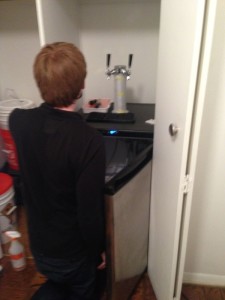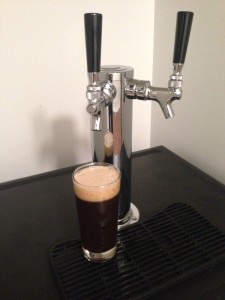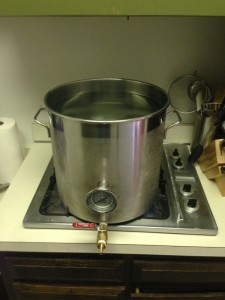When I first started brewing, I was convinced it’d only be a means to cheaper IPA. The micro-brewery explosion in Ireland wasn’t yet a thing – IPAs didn’t line the shelves of beer stores. I was entirely sure I’d continue to buy IPA-ready kits with hopped malt that I just added yeast to, and that’d be that.

The Early Days ~2009, pretty sure this was a stout
After a while, I found most results were pretty disappointing, college got in the way, and my brewing took a hiatus. After graduation, I discovered how easy it was to design my own IPA recipes using dried or liquid malt extracts and hop additions in the boil, rather than using awful beer kits. The result was a beer orders of magnitude better, and I’d still invested in little more than the $96 in a getting-started brewing kit. I still insisted I wasn’t going to get too caught up in recipe calculation and numbers – random experimentation was more fun.
This style of brewing continued over a number of batches, and eventually I started using a brewing calculator, and learned about International Bitterness Units (IBUs – how bitter an IPA I’d end up with) and SRMs (colour of the beer). Seems a little precise, considering my ambition not worry the about numbers? What did I know, it was the beginning of a slippery slope.
Another life event caused a brief brewing hiatus – I’d moved to the Boston. In fact, it was only about 4 months before I’d started another brew. On my first trip home, I brought over as much of my brewing equipment as I could, and bought the larger items in a local home brewing store in Cambridge. bottling After an incredibly successful IPA, a cider batch and a turbo IPA, spirits were high – then the Raspberry Wheat happened. The extract brew went swimmingly, and I bottled with a small amount of artificial brewers Blueberry and Raspberry extract. Mistake #1 – that stuff tasted woeful. Never brewing with anything but real fruit in future, even if it introduces tricky natural yeasts.
The second mistake, the entire batch ended up infected in the bottle after only a week or so. The bottles hadn’t been sanitised properly.
Bottling was always a hassle, and the infection fiasco caused an entire batch to be ruined – something I didn’t want to repeat, so it was time to invest again. This time, I’d decided to start kegging beer. This would be an expensive ticket item – not only did I need a keg to put the beer in, but also a means of constantly refrigerating it, and Co2 to dispense it. I needed a kegerator – but new, these were crazy expensive. Cue craigslist, and $200 later I had a kegerator which I could convert to take homebrewing kegs – essentially the leftovers of old Pepsi Cola soda machines.
Thanks to the help of Dan Logcher, who resells kegging equipment for very reasonable prices, I had bought my first keg, and Dan converted the kegerator to a home brewing setup, all for a little shy of $100. So, I’ve got beer on-tap – the advantages of which are innumerous, and $300 in so-far.

Adding the two-tap system to the kegerator
After running a fantastic Red Ale through the kegerator, it was clear that kegging was an excellent upgrade – bottling takes hours, and is messy business. Kegging takes 30 minutes, and beer can be carbonated and ready to drink in days rather than weeks! The only complaint was a lack of variety – more on that later.
After a very successful red ale, I wanted to try something new. Now that I had a dedicated brewing fridge in the form of the kegerator, I could make lagers as well as ale – a style of beer which requires cold fermenting temperatures. I’d decided to make a very different lager, a smoked black lager. It wasn’t possible to achieve that smoked flavour without introducing a new technique, however. Rather than using malt extract, I’d extract the fermentable sugars from crushed grain.
After a very successful brew of the Smoked Black Lager, and after finishing the red ale, it was time to put it on tap. This time however, I wanted some variety. It was time to upgrade the kegerator.

The Smoked Schwarzbier
The faucet the kegerator came with was pretty grimy from years of Bud Lite flowing through the tap, so buying a new Beer Tower with 2 faucets ($93, amazon) attached was a worthwhile investment. From here, back to Dan to buy another Corny Keg to drive the second tap, and for the modifications to the regulator ($87). So, another $180 to be able to dispense two kegs rather than one. Priceless?
The spending hasn’t ended there. When brewing the black lager, using some crushed grain perked an interest in the most advanced type of brew – all grain brewing. Malt extract is expensive (~$5/lb), grain is cheap (<$2/lb). I discovered without much extra equipment, I could brew all grain. All I’d need was a new brew kettle, and a mesh bag.
The brew kettle was an expensive ticket item, but I’d been using a cheap 3 gallon stock pot for too long. After scouring eBay and Craigslist, nothing suitable was to be had used – I’d need to buy new.
Adventures in Homebrewing had a 9 gallon kettle with ports for a thermometer and ball valve, exactly what I wanted. They warned in the description this was a cheap kettle – but no matter! I opted for the high-end bilchmann thermometer, which screws into the kettle – and this felt sacrilege. Blichmann products are the holy grail of brewing equipment. This thermometer felt like a crafted precision instrument. The kettle was a cheap piece of tin, but it boils!

The Kettle, in all it’s glory
I also bought a copper wort chiller, to cool the beer from the kettle. I’d previously spent 4-5 hours waiting for wort to cool in ice baths, in the freezer – unconventional means, leaving beer susceptible to infection.
So, a new kettle ($125), and a chiller ($44) to add to the investment list.
The last investment is in a more advanced piece of brewing calculator software ($28). So here I find myself, doing just about everything I swore I’d never do. Using advanced equipment, spending many many hours preparing a batch. Calculating precise recipes, altering water profiles, measuring every conceivable variable – mash efficiency, pre-boil gravity, trub loss. At this point, I need to admit the inevitable – I’m a beer nerd.

Adding hops
But what’s the purpose of this post? I’ve ranted for paragraphs about how much money I’ve spent on brewing, so it’s in part a confessional. I’m really hooked. Now, it’s time for some dubious justifying man-math[1].
I’ve probably produced ~14 successful 5 gallon batches of beer across my brewing career, which spans about 7 years on-off. Because I was mostly brewing obscure things expensive to buy in Ireland, I’m assuming a low unit cost in Ireland of €2.50 per 500ml of craft beer, or $3.46. I’m also ignoring the substantial difference between US and imperial gallons, but to my disadvantage.
Lastly, I’ll assume each recipe cost $50 in ingredients. This is a little on the high side, however most of my batches were brewed in Ireland.
Buying Beer Commercially
Gallons of beer produced: ~70 US gallons = 265,000ml
500ml Bottles of beer produced: 265000ml/500ml = 530
Cost in store of beer produced: 530*$3.46 = **$1833.8 of beer. **
Now, how much have I spent on equipment?
Cost of ingredients over all batches: 50*(14+2) = $800 (includes 2 failed batches)
Kegerator costs (total): $480
Initial equipment kit as bought in Ireland): $96
Craigslist 3Gal Kettle: $10
Buckets & bulky equipment re-bought in US: $40
New 9gal kettle & immersion chiller: $169
BeerSmith software: $28
**Total: $1,623**
Profit: $210.8
So, by some incredibly dubious man-math, I’ve managed to justify my staggering investment over the years in brewing equipment, and somehow turn a profit. Everything I’ve bought has been as frugal as possible – a lot of the equipment is used, or bought on sale.
I guess the true take-home of this post is although this is a hobby, which I really enjoy, to see a true ROI, I need to start brewing a lot more over the coming months.
Brewing has been a slippery slope – but thankfully not that kind of slippery slope. Over the course of 16 batches of beer over the last 7 years, somehow I haven’t managed to turn into an alcoholic. Becoming an increasing beer nerd forces me to focus on the flavour and pallet of different beers – I can’t even remember the last time I was remotely inebriated. My favourite part of craft beer is finding people to share the produce with, and with 5 gallon batches that becomes a necessity pretty quickly! It’s a common trait amongst home brewers – if you want free beer, don’t be afraid to ask!
Hell, next time – bring a growler!
[1] Term coined by Chris Harris, automotive journalist when trying to justify buying expensive super cars. http://www.pistonheads.com/doc.asp?c=173&i=26140